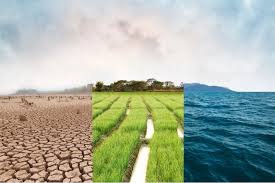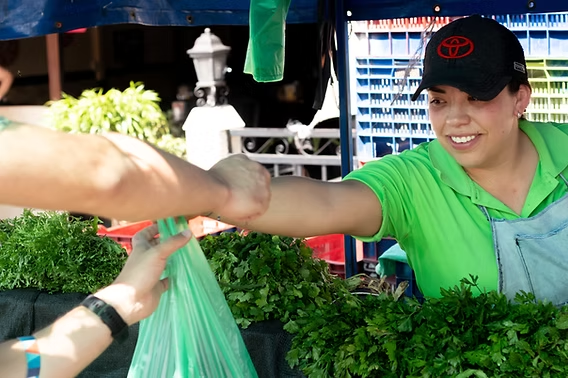Outline
The Global Climate Crisis
- Rising global temperatures are leading to more frequent and severe heatwaves, directly impacting crop yields.
- Shifting rainfall patterns disrupt planting and harvesting seasons, leading to droughts and floods.
- Increased occurrences of extreme weather events like hurricanes and wildfires cause devastating crop damage.
Impacts on Agricultural Practices
- Farmers are facing increased pest infestations as warmer temperatures allow pests to thrive in new regions.
- Soil degradation and desertification are becoming more prevalent due to changing weather patterns.
- Water scarcity is a growing concern, leading to competition for limited resources and impacting irrigation systems.
The Struggle for Food Security
- Climate change threatens food security by disrupting food production and supply chains.
- Rising food prices impact consumers and exacerbate poverty and hunger.
- Vulnerable populations, particularly in developing countries, are most impacted by food shortages.
Sustainable Solutions for a Resilient Future
- Agroecological practices like crop diversification and conservation tillage can enhance soil health and climate resilience.
- Investing in climate-smart agriculture technologies can help farmers adapt to changing conditions.
- Policy changes to support sustainable farming practices and promote food security are crucial for long-term solutions.
A Call to Action: Our Collective Responsibility
- We can all play a role in mitigating climate change by reducing our carbon footprint and advocating for sustainable policies.
- Supporting local farmers and promoting sustainable agriculture practices helps build a more resilient food system.
- Collective action is essential to address climate change and ensure a future where food security and environmental sustainability are prioritized.
The Global Climate Crisis: A Growing Threat to Agriculture and Food Security

Introduction
Climate change is no longer a distant threat—it’s a present-day crisis that directly affects agriculture, food production, and the global economy. Rising temperatures, erratic rainfall, and frequent natural disasters are putting pressure on farmers and food systems worldwide. In this article, we’ll explore how climate change is impacting agriculture, threatening food security, and what sustainable steps can be taken to build a resilient future.
Heatwaves: A Silent Crop Killer
One of the most alarming effects of climate change is the increase in global temperatures. The Earth has already warmed by more than 1°C since the pre-industrial era, and this number is steadily climbing. More frequent and severe heatwaves are causing plants to wilt, reducing their ability to photosynthesize and grow. Critical food crops such as wheat, rice, and maize suffer substantial yield losses during prolonged periods of extreme heat. In many developing countries, where agriculture is a major source of income, this spells disaster for millions of farmers. For more on how extreme weather affects agricultural productivity, read our article onhttp://agriculture and weather patterns.
https://www.un.org/en/global-issues/climate-change
Rainfall Disruptions: Floods and Droughts

Rainfall patterns are also changing in unpredictable ways. Shifting monsoon cycles and erratic precipitation are making it difficult for farmers to determine the best time to plant or harvest their crops. This unpredictability leads to poor yields and crop failures. In some regions, extended dry spells cause devastating droughts, reducing water availability for irrigation. In other places, excess rainfall leads to floods, destroying crops and eroding fertile soil. These extreme conditions not only impact food production but also increase the risk of famine and food insecurity.
Extreme Weather: Hurricanes, Cyclones, and Wildfires
The world is also experiencing a rise in extreme weather events. Powerful hurricanes, unexpected cyclones, and fast-spreading wildfires are now more common due to changing climate conditions. These disasters wipe out entire harvests, damage farmland, and destroy essential infrastructure. For instance, in recent years, countries like Pakistan, the Philippines, and the United States have faced major agricultural losses due to floods and storms caused by climate change. These events increase costs for recovery and leave farmers with reduced or no income.
Conclusion: A Call to Action
The climate crisis is deeply interconnected with global food security. If current trends continue, millions more will face hunger, poverty, and displacement. Governments, farmers, researchers, and communities must work together to adopt climate-smart agricultural practices, invest in resilient infrastructure, and reduce greenhouse gas emissions. Protecting our planet means protecting the future of food for everyone.
Impacts on Agricultural Practices: How Climate Change is Reshaping Farming

The agriculture sector, the backbone of global food security, is under increasing pressure due to the growing impact of climate change. As global temperatures rise, farmers are facing new and intensifying challenges that are forcing them to adapt quickly. From pest infestations to soil degradation and water scarcity, climate change is fundamentally transforming how we grow food. Let’s explore the most pressing ways agricultural practices are being affected.
Pest Infestations on the Rise
One of the most noticeable and damaging consequences of climate change in agriculture is the increase in pest infestations. Warmer temperatures are allowing pests and invasive species to survive in areas where they previously couldn’t. As a result, regions that were once safe from certain insects, such as locusts, aphids, and beetles, are now seeing outbreaks that threaten entire harvests. This not only reduces crop yields but also increases the need for pesticides, which can negatively impact the environment and human health.
For example, studies have shown that a 2°C rise in temperature can lead to a significant increase in insect-related crop losses, particularly in staple crops like wheat, rice, and corn. Farmers are now having to implement more pest-resistant crop varieties and invest in integrated pest management systems, all of which raise production costs.
Soil Degradation and Desertification
Another serious issue farmers are facing is soil degradation. Due to changing rainfall patterns and extreme weather events, the quality of agricultural soil is declining, leading to reduced fertility and productivity. Erosion, nutrient loss, and desertification—the process by which fertile land becomes desert—are becoming more widespread in areas that once supported healthy crop growth.
This trend is especially alarming in regions like sub-Saharan Africa and South Asia, where agriculture is the main livelihood. The loss of healthy soil threatens not just food production, but also biodiversity and carbon storage. Farmers need to adopt sustainable soil management practices like cover cropping, no-till farming, and organic composting to restore soil health and reduce emissions.
Water Scarcity: A Looming Crisis
Perhaps the most critical concern is water scarcity. With longer dry seasons and more unpredictable rainfall, access to freshwater for irrigation is becoming a major challenge. Rivers, lakes, and underground aquifers are drying up, increasing competition for limited water resources among farmers, cities, and industries.
In many parts of the world, inefficient irrigation methods result in massive water loss. Modern solutions like drip irrigation and rainwater harvesting are becoming essential for climate-resilient farming. Additionally, governments and local communities must work together to promote equitable water management policies to ensure long-term sustainability.
Conclusion: Rethinking Agriculture in the Face of Climate Change
The impacts of climate change on agricultural practices are real, urgent, and growing. Farmers must innovate, adapt, and collaborate with researchers and policymakers to create more sustainable and climate-resilient food systems. Without bold action, the future of global food security remains uncertain.
The Struggle for Food Security: How Climate Change is Deepening the Global Crisis
Food is a basic human right, yet millions of people across the globe go to bed hungry every night. In recent years, the issue of food security has grown even more urgent, driven by the increasing impacts of climate change. From reduced crop yields to disrupted supply chains and soaring food prices, the struggle for food security is becoming one of the most critical challenges of our time.
🌾 Climate Change and Disrupted Food Production
At the heart of the food security crisis is the disruption of agricultural systems caused by global warming and extreme weather. Climate change affects crop growth in numerous ways—rising temperatures, irregular rainfall, prolonged droughts, floods, and shifting growing seasons all contribute to unstable food production.
Many regions that rely on predictable weather patterns to grow staple crops like wheat, rice, and maize are now facing declining harvests. These drops in production not only reduce local food availability but also impact global supply chains, driving up costs and creating shortages in markets far from the original production zones.
💸 Rising Food Prices and Widespread Hunger
As food supplies become unstable, prices are rising rapidly. According to the United Nations Food and Agriculture Organization (FAO), global food prices have surged in recent years due to climate disruptions, high input costs, and logistical challenges. These increases are especially devastating for low-income families who already spend a large portion of their income on food.
Rising food prices deepen poverty, malnutrition, and hunger, especially in regions where food access is already limited. For example, during droughts in East Africa or floods in South Asia, basic staples can become unaffordable or unavailable, pushing millions further into food insecurity.
👥 The Most Vulnerable Are the Hardest Hit
While climate change is a global issue, its impact on food security is not felt equally. Vulnerable populations in developing countries suffer the most. Smallholder farmers, landless laborers, and urban poor communities often lack the resources and safety nets needed to cope with price hikes and food shortages.
In countries across Africa, South Asia, and Latin America, climate-induced food insecurity is leading to increased displacement, child malnutrition, and social unrest. Women and children are especially at risk, as they often eat last or least in food-insecure households.
✅ Conclusion: Building a Resilient Food Future
Solving the food security crisis requires global cooperation and climate-smart agricultural solutions. Governments, NGOs, and communities must invest in sustainable farming, efficient supply chains, and social safety programs to ensure that everyone has access to affordable, nutritious food. The future of food depends on bold action today.
Sustainable Solutions for a Resilient Future: Building Climate-Smart Agriculture Today
In an era where the effects of climate change are becoming increasingly visible, the need for sustainable farming has never been greater. Agriculture, which is both a victim and contributor to climate change, holds the key to creating a more resilient and food-secure future. To combat environmental degradation and support farmers worldwide, we must turn to agroecological practices, climate-smart technologies, and supportive policy frameworks.
🌱 Agroecological Practices for Soil and Climate Health
One of the most powerful tools for building agricultural resilience is agroecology. This sustainable approach combines traditional farming knowledge with modern science to enhance biodiversity, soil health, and ecosystem balance. Practices like crop diversification, conservation tillage, cover cropping, and organic composting reduce reliance on chemical inputs and improve the soil’s ability to retain water and nutrients.
For example, crop rotation and intercropping not only reduce pest pressure naturally but also improve yields and restore soil fertility. Similarly, conservation tillage minimizes soil disturbance, preserving soil carbon and reducing erosion. These nature-based solutions are cost-effective, eco-friendly, and climate-resilient—ideal for farmers in both developing and developed countries.
🔧 Climate-Smart Agriculture Technologies
To adapt to rapidly changing conditions, climate-smart agriculture (CSA) is essential. This approach integrates technology, innovation, and data to help farmers maintain productivity while reducing greenhouse gas emissions. Key innovations include:
- Precision irrigation systems that reduce water waste
- Drought- and heat-tolerant seed varieties
- Mobile-based weather forecasting and advisory tools
- Remote sensing and satellite imagery for monitoring crops
These tools help farmers make informed decisions, optimize resource use, and reduce losses from climate extremes. Investing in such technologies ensures that food production can keep pace with population growth while protecting natural resources.
🏛️ Policy Support for Sustainable Agriculture
Technological and agroecological solutions alone are not enough without policy reforms that prioritize sustainability. Governments must support farmers with incentives, subsidies, and technical assistance that encourage climate-friendly practices. Additionally, policies should promote access to markets, fair pricing, and land rights for smallholder farmers—especially women and marginalized communities.
Public and private partnerships, research institutions, and global organizations must also work together to fund innovation, build resilience in rural areas, and ensure that food systems are both inclusive and sustainable.
✅ Conclusion: A Greener Path Forward
The challenges facing global agriculture are enormous—but so are the opportunities. By embracing sustainable farming practices, climate-smart technologies, and smart policy decisions, we can ensure a resilient food future for generations to come. Now is the time to act boldly, invest wisely, and commit to a greener planet.
A Call to Action: Our Collective Responsibility for a Sustainable Future

The climate crisis is no longer a distant threat—it’s a reality that affects our daily lives, especially when it comes to food production, water access, and environmental stability. As the world faces rising temperatures, unpredictable weather, and growing food insecurity, the need for collective action has never been more urgent. Every individual, organization, and government has a role to play in building a sustainable, climate-resilient future.
🌍 Reduce Your Carbon Footprint

One of the most impactful ways individuals can contribute is by reducing their personal carbon footprint. Simple lifestyle changes—such as using public transport, reducing energy consumption, minimizing food waste, and choosing sustainable products—can collectively have a significant effect on greenhouse gas emissions.
Supporting eco-friendly initiatives and raising awareness in your community also plays a vital role. Whether it’s choosing renewable energy, planting trees, or advocating for green policies, your actions matter. Climate change may seem like a massive challenge, but when millions commit to small changes, they create powerful results.
🌾 Support Local Farmers and Sustainable Agriculture

Food systems are at the heart of the climate crisis, but they are also part of the solution. By supporting local farmers, choosing organic and sustainably grown foods, and reducing meat consumption, consumers can help lower agricultural emissions and promote biodiversity.
Local, small-scale farmers often use traditional, eco-conscious methods that protect soil health, conserve water, and reduce chemical usage. When you buy from them, you’re not only helping the environment but also boosting local economies and ensuring food sovereignty.
Spreading awareness about climate-smart agriculture and urging policymakers to invest in sustainable food systems is another powerful way to drive long-term change.
🤝 The Power of Collective Action

Tackling climate change and ensuring food security are not challenges that can be solved alone. Collective action is key—whether it’s in your neighborhood, your workplace, or at the national level. Collaborate with local organizations, join environmental campaigns, and participate in climate movements to amplify your impact.
Governments and corporations must be held accountable through public demand for sustainable policies and responsible practices. Together, we can shape a world that prioritizes environmental health, equity, and food for all.
✅ Final Thoughts: Your Voice Matters
Our planet is at a crossroads. The choices we make today will determine the quality of life for future generations. From reducing emissions to supporting sustainable agriculture, each step we take can contribute to a healthier, more resilient world. It’s time to act—because the future is not only in our hands, it is our responsibility.
For more tips on sustainable living and supporting agriculture, visit our http://agriculture and sustainability blog.

